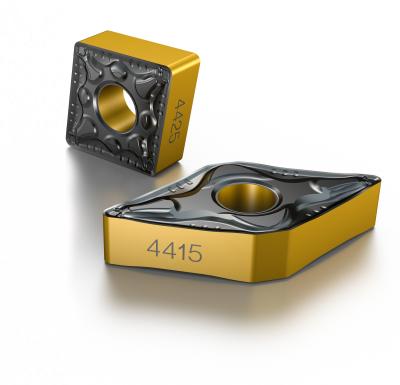
Sandvik Coromant is upgrading its range of turning inserts for machining ISO P steels. The tooling specialist has launched two new carbide grades designed for external and internal machining of low-alloyed and unalloyed steels. The new inserts, called GC4415 and GC4425, deliver increased toughness, heat resistance and predictable wear.
GC4415 and GC4425 are ideal for manufacturers operating in mass and batch production setups machining low-alloyed (P 2.1 to 2.6) and unalloyed (P 1.1 to 1.5) steels, respectively.
Grade GC4425 has been shown to outperform competing inserts in a majority of steel turning applications. It features improved wear, heat resistance and toughness, which significantly expands the application range. Both it and GC4415 can be used from finishing to roughing in applications with continuous cuts and light interruptions.
Meanwhile, GC4415 is designed to complement GC4425 when enhanced performance and more heat resistance are needed. In addition, the materials’ new post-treatment has been found to boost performance in intermittent cutting operations, avoiding any sudden breakages and enabling both insert grades to outperform over a broad application range.
“Generally speaking, every manufacturer wants to achieve the following goals: increased metal removal rates, more pieces per edge, reduced cycle times, minimized waste and optimized inventory use,” said Johan Anderstedt, Global Product Manager Turning at Sandvik Coromant.
“For manufacturers with a batch production setup, this also means having the flexibility to machine multiple steel materials with the same grade. Our new GC4415 and GC4425 grades can help you achieve this—even with tough and complex ISO P materials.”
Enhanced wear resistance
The GC4415 and GC4425 inserts show superior wear resistance over competing inserts, which contributes to extended tool life and predictable performance with every use. This also minimizes material waste, both from the workpiece and the insert.
The inserts’ superior wear resistance is attributed to Sandvik Coromant’s second-generation Inveio®technology, an alumina coating layer. What makes Inveio unique can be seen at a microscopic level; its surface is characterized by a unidirectional crystal orientation.
Each crystal is lined up towards the cutting edge, creating a strong barrier that improves crater and flank wear resistance. Heat is also lead away from the cutting zone more quickly, which keeps the cutting edge in shape for longer. The result is a harder-wearing tool.
For better sustainability, the carbide substrate of these new grades contains a high proportion of recycled carbide material, more than 40%. Making grades from recycled material conserves virgin raw material, requires less energy and emits less CO2 in production.
Lower production cost
Customers have been able to implement higher cutting speeds (vc) and compounded feed rates (fn) with the new carbide inserts.
In one case, a general engineering manufacturer subjected a 4140 pre-heat treated steel workpiece to multi-directional external roughing with the GC4425 insert. Compared with using a competitor’s ISO insert for the same process, the customer was able to achieve a 100% productivity increase, with a reduced cycle time of 50% plus a 30% cost reduction.
To help customers optimize their cutting speeds and feed rates, as well as identify the best insert or tool for their requirements, Sandvik Coromant has also developed its online CoroPlus® Tool Guide.
“GC4425 and GC4415 give prolonged tool life in some of the most challenging cutting conditions,” added Anderstedt. “Combined with Sandvik Coromant’s close partnership and the Tool Guide, our customers can achieve higher productivity, a lower cost per part and more profitable production.”
Contact Details
Related Glossary Terms
- feed
feed
Rate of change of position of the tool as a whole, relative to the workpiece while cutting.
- flank wear
flank wear
Reduction in clearance on the tool’s flank caused by contact with the workpiece. Ultimately causes tool failure.
- turning
turning
Workpiece is held in a chuck, mounted on a face plate or secured between centers and rotated while a cutting tool, normally a single-point tool, is fed into it along its periphery or across its end or face. Takes the form of straight turning (cutting along the periphery of the workpiece); taper turning (creating a taper); step turning (turning different-size diameters on the same work); chamfering (beveling an edge or shoulder); facing (cutting on an end); turning threads (usually external but can be internal); roughing (high-volume metal removal); and finishing (final light cuts). Performed on lathes, turning centers, chucking machines, automatic screw machines and similar machines.
- wear resistance
wear resistance
Ability of the tool to withstand stresses that cause it to wear during cutting; an attribute linked to alloy composition, base material, thermal conditions, type of tooling and operation and other variables.

